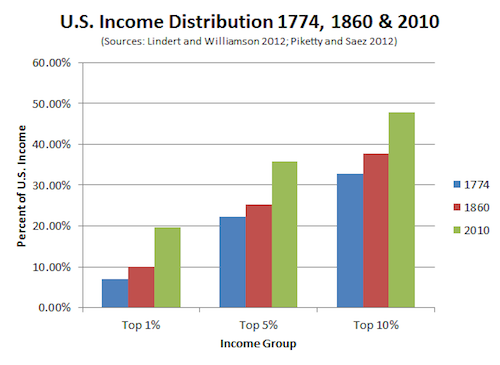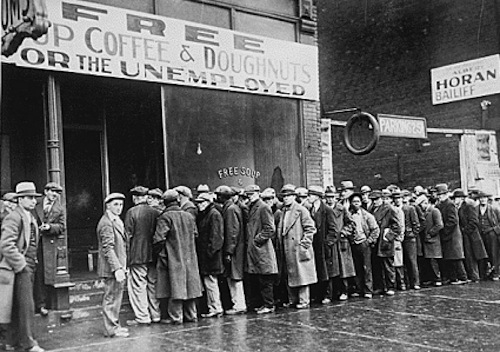If only there were some way to make this graph that did not put percentages on both axes. That would be class warfare, though. You’re looking at a visual representation of historical US income inequality that is A) extremely conjectural in red and blue, and B) terrifying. It’s from this article in the Atlantic, which tentatively alleges that ours is a less equal America than it was on the eve of the Revolution and the Civil War. Numerous qualifications after the jump.
Tag Archives: inequality
Monday is for wild, logarithmic speculation
In part because we wake gripped by existential terror every morning, we at the Combat! blog offices like to paint the present American moment as one of unusual discord. In this way, we resemble our predatory stepbrothers in the more, ahem, widely-consumed media, who often act as if American politics were more fractious now that it was in, say, the 19th century. Such claims seem convincing—I totally see more modern people accusing one another of not being citizens than I see knickerbockers settling disagreements with sword canes—but how can I know? If only there were some means of quantifying intranational dissent, so I could know with mathematical certainty how the partisan turmoil of my age compares to that of my forebears. I suppose I’ll just have to give up and read the Bi—boom! Logarithmic plotting of correlation between stock market crashes and secessionist movements, pussies! Props to James Erwin, not only for the link but for much of the original research used in the link. He’s also raising a child.
What to do about those pesky poor
Now that a new Congress has convened and pledged itself to beating back the deficit we accumulated out of nowhere in the last two years, we have to think about poor people. Personally, that’s something I try to limit to the ten or so minutes it takes me to get in and out of Taco Bell, but it so happens that A) poor people are where we’re going to trim the deficit, since wars, social security and tax cuts for the rich are utterly indispensable, and B) present conditions mean that there are a lot more of them. It turns out that a high school dropout and a 40 of Old English isn’t the only way to make new poor people. You can also do it with a massive economic contraction. As any recently unemployed person will tell you, those are the good kind of poor people: the ones who love work and being responsible, but who through no fault of their own have been temporarily deprived of their opportunity to do either. Such hard-working, down-on-their-luck Americans are the ones we are obliged to help. But how to do it without also giving professional poor people a free ride?
Slate’s Timothy Noah on income inequality
Slate is midway through what is threatened to be a two-week series on income inequality in America, just in time for the controversial announcement that the President will not try to solve the economy by giving more money to rich people. Timothy Noah looks at several putative dangers to America’s middle class, including immigration, racism/sexism, and computers, none of which accounts for the growing gap between rich and poor in the United States. That gap is enormous. Currently, the wealthiest 1% of Americans take home 24% of the national income. Between 1980 and 2005, more than 80% of the nation’s considerable increase in earnings went to that 1%. To put that in perspective, back in 1915—the era of the Carnegies, Vanderbilts and Rockefellers, as well as a generation of non name-brand robber barons—the top 1% only got 18%. Economically, ours is a less equal America than that of our great grandparents.




